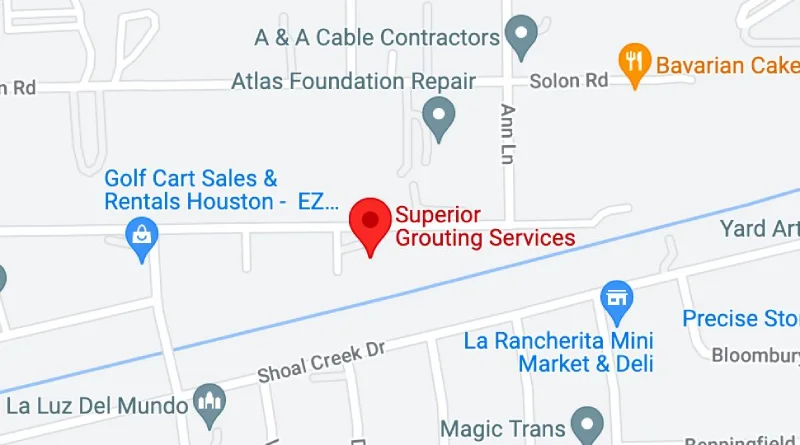What Is The Best Fill Under A Concrete Slab in Houston, TX?

Houston’s heavy‐clay subgrade, punishing Gulf Coast rain, and extreme temperature swings make concrete slabs—especially large industrial concrete floors—vulnerable to hidden voids and sudden settlement. Whether you are pouring a brand-new slab foundation or restoring an existing concrete surface, choosing the right void fill is mission-critical for structural integrity, safety, and lifecycle cost.
This detailed guide explains why voids form, how different fill materials perform in Houston, and why high-density polyurethane foam injection has become the go-to solution for industrial facilities that demand rapid return to service with minimal disruption.
Key Takeaways
- Houston’s clay soil expands when wet and shrinks when dry, creating voids under concrete slabs.
- Properly compacted granular subgrade is ideal for new construction, but existing voids require a specialized fill.
- High-density, closed-cell polyurethane foam expands to fill a void, blocks water, and delivers compressive strength up to 8,000 psf—far exceeding traditional mudjacking slurry.
- Polyurethane foam injection minimizes downtime, offers precise soil stabilization, and is often the most cost-effective repair for industrial concrete in Houston, TX.
- Partnering with a local void filling service that understands Greater Houston geology is crucial to achieve slab stability and avoid future slab failure.
Understanding Void Formation Beneath Concrete
Voids under concrete slabs rarely announce themselves until forklifts begin rocking, joints start faulting, or a sudden slab drop interrupts operations. Common causes include:
- Soil Erosion – Heavy Gulf Coast storms wash fines out from beneath concrete, creating hollow pockets.
- Poorly Compacted Subgrade – When original fill was not properly compacted, gradual consolidation leaves gaps.
- Plumbing or Utility Leaks – Pressurized water lines beneath the slab can scour pathways through clay.
- Organic Decay – Construction debris, roots, or organics left in the subgrade decompose, reducing bearing capacity and moisture content.
Regardless of the cause, the solution is to effectively fill and stabilize the void while restoring design elevation.
Why Houston’s Clay Magnifies the Problem
Houston’s surface geology is dominated by highly plastic clays that expand when wet and shrink hard during drought. The constant swell-shrink cycle breaks the bond between slab and subgrade, initiating tiny voids that grow over time. Because clay also has low drainage, trapped moisture adds extra weight and reduces bearing capacity and moisture strength ratio, accelerating settlement.
Any successful void fill must:
- Displace or seal trapped water to stop swelling.
- Deliver high compressive strength to bridge weak clay.
- Remain dimensionally stable despite temperature swings common in Greater Houston.
Comparing Fill Options for Voids Under Concrete Slabs
Below is a breakdown of the three most common industrial void filling methods in Houston, TX.
Traditional Mudjacking (Cement Slurry)
- Mix of water, clay, sand, and cement is pumped under pressure.
- Typical density is 120–140 lb/ft³, adding significant weight to already weak soil.
- Large 1½–2” injection holes scar the concrete surface.
- Long cure times translate to extended downtime.
Mudjacking can lift and level a slab, but its high weight can cause further settlement in saturated clay. It is seldom the best solution for heavy industrial concrete structures.
Cementitious Pressure Grouting
Pressure grouting uses a flowable cementitious slurry engineered for higher strength and lower water. It is superior to basic mudjacking but still adds mass. It also requires 24–48 hours of downtime before equipment loads are allowed back onto the slab. In some cases, grouting is combined with lime treatment to improve clay bearing capacity.
High-Density Polyurethane Foam Injection
High-density polyurethane foam weighs only 2–6 lb/ft³ yet can reach compressive strengths exceeding 8,000 psf. The closed-cell foam expands rapidly (typically 20–30× liquid volume), allowing it to:
- Chase and seal micro-voids that cement grout cannot reach.
- Block water infiltration and stop soil erosion paths.
- Lift concrete slabs to precise tolerances via incremental, computer-controlled injection.
- Reach 90 % strength in 15 minutes, giving you a rapid return to service and minimal production downtime.
Polyurethane foam injection is the preferred method for industrial plants, port facilities, and warehouse operators across Houston who cannot afford prolonged shutdowns.
Polyurethane Foam Injection Process Step-By-Step
- Site Evaluation & Elevation Survey – Superior Grouting technicians map slab deflection with laser levels to determine where voids under concrete exist and how much lift is required.
- Drilling Small Injection Ports – ⅝” holes are drilled in a tight grid pattern; these tiny ports are almost invisible after patching.
- Foam Is Injected – Two liquid components mix in the injection gun. As polyurethane reaches the subgrade, it expands, fills the void, and gently lifts the slab.
- Real-Time Monitoring – Technicians monitor ride height and grade to prevent over-lifting.
- Cleanup & Joint Sealing – Ports are patched with rapid-set cementitious material. Control joints are sealed to lock out future moisture.
- Immediate Re-Use – In most cases, forklifts, semitrailers, and heavy racks can be returned to the slab within one hour.
Because the foam expands, it can also improve soil stabilization by penetrating interstitial spaces and bonding loose subgrade particles.
Cost Factors That Influence Your Void Filling Budget
Cost factors vary, but polyurethane foam injection often delivers the lowest life-cycle cost when you consider speed, durability, and reduced downtime:
- Minimum Project Size – Mobilization charges make very small repairs less economical; industrial projects easily surpass the threshold.
- Cubic Feet of Void – Foam volume is calculated from laser readings and confirmed during injection.
- Pounds per Cubic Foot – Heavier-duty slabs may require higher-density foam for superior compressive strength.
- Accessibility & Overhead – Confined equipment pits or mezzanines may need specialty rigs.
- Slab Thickness & Reinforcement – Heavily reinforced industrial concrete requires precise pressure control to prevent cracking.
A good rule of thumb: polyurethane foam costs more per pound than mudjacking slurry but far less per hour of plant downtime.
How Superior Grouting Protects Industrial Concrete Structures
Operating since 1983, Superior Grouting is the largest provider of polyurethane foam injection services in Houston. Our technicians understand the unique challenges of Gulf Coast clay and the demands of industrial clients who cannot afford slab failure. We routinely support:
- Oil & gas terminal floors
- Food & beverage processing plants
- Distribution centers with high-speed forklifts
- Airport runways and taxiways
- Heavy manufacturing assembly lines
By combining geotechnical expertise, high-density foam chemistry, and state-of-the-art injection equipment, we help facilities restore their concrete, maintain structural integrity, and avoid costly slab replacement.
Selecting a Houston Void Filling Service—A Quick Checklist
- Are they licensed to perform geotechnical pressure grouting in Texas?
- Do they provide soil borings or at least Dynamic Cone Penetrometer tests to confirm subgrade strength before injection?
- Can they deliver closed-cell, hydrophobic foam that will not absorb water?
- Do they offer a written warranty on both lift and void fill results?
- How many similar industrial concrete projects have they completed in Greater Houston within the past year?
Asking these questions will ensure your slab needs are met with the right type of repair.
Conclusion
For new industrial slabs, a well-compacted granular base remains essential. However, once a void under a concrete slab develops, no amount of granular backfill can magically inject itself beneath the slab. In clay-rich Houston, high-density polyurethane foam injection clearly outperforms traditional mudjacking and cementitious grouting by delivering:
- Lighter weight, high compressive strength support
- Superior soil stabilization and moisture blocking
- Rapid return to service, slashing downtime costs
- Precise, computer-controlled lifting of concrete slabs and structures
If you’re facing uneven floors, rocking joints, or visible voids under concrete slabs, contact Leveled Concrete and Superior Grouting for a data-driven evaluation. Our polyurethane foam injection process will effectively fill the void, restore your concrete, and safeguard your operation’s productivity for years to come.


